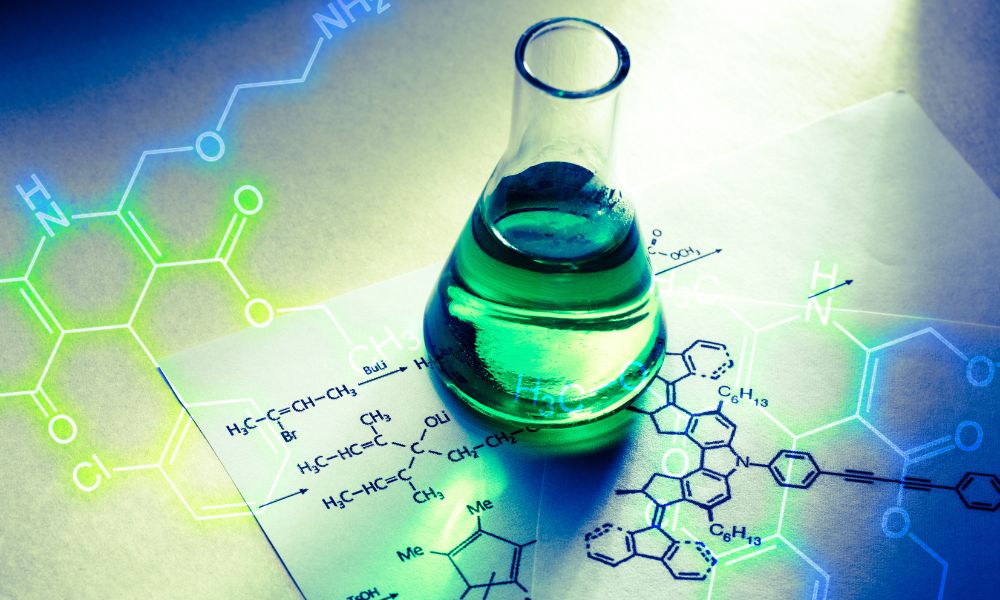Chemical reactions are essential to the world around us, from the simplest processes in nature to the most complex industrial applications. There are countless types of chemical reactions, but they can get classified into four main categories: synthesis, decomposition, single displacement, and double displacement reactions. Read on for an understanding of the four main types of chemical reactions.
Synthesis Reactions (Combination Reactions)
A synthesis reaction, otherwise known as a combination reaction, occurs when two or more reactants combine to form a single product. These reactions are typically represented by the following general form:
A + B → AB
Synthesis reactions are typically exothermic, meaning they release energy in the form of heat. These reactions are crucial in the formation of new compounds and play a significant role in various natural processes and industrial applications.
One of the most recognizable synthesis reactions is photosynthesis. In this process, plants convert carbon dioxide and water into glucose and oxygen using sunlight as an energy source.
Examples of Synthesis Reactions
Let’s look at a few common synthesis reactions to give you a better understanding.
Formation of Water
2H₂(g) + O₂(g) → 2H₂O(g)
In this example, hydrogen gas (H₂) and oxygen gas (O₂) combine to form water (H₂O). This reaction is a vital component of combustion processes, such as the burning of hydrogen fuel.
Formation of Magnesium Oxide
2Mg(s) + O₂(g) → 2MgO(s)
When magnesium metal (Mg) gets heated in the presence of oxygen gas (O₂), it forms magnesium oxide (MgO), a white solid. This reaction is an example of a metal reacting with a non-metal to form an oxide.
Formation of Sodium Chloride
2Na(s) + Cl₂(g) → 2NaCl(s)
In this reaction, sodium (Na) combines with chlorine gas (Cl₂) to produce sodium chloride (NaCl), also known as table salt. The reaction is highly exothermic and illustrates the formation of an ionic compound from its constituent elements—it also makes food taste good!
Decomposition Reactions
Decomposition reactions fall on the other end of the spectrum from synthesis reactions. In a decomposition reaction, a single compound separates into two or more simpler products. These reactions often require an input of energy, such as heat, light, or electricity, and are generally endothermic, meaning they absorb energy. You can represent decomposition reactions with the following general form:
AB → A + B
Decomposition reactions occur in nature, contributing to the breakdown of complex compounds into simpler ones. For example, the decomposition of organic matter by microorganisms is essential for the recycling of nutrients in ecosystems.
Examples of Decomposition Reactions
Read on and learn a few types of decomposition reactions.
Electrolysis of Water
2H₂O(l) → 2H₂(g) + O₂(g)
In this example, water (H₂O) decomposes into hydrogen gas (H₂) and oxygen gas (O₂) when an electric current passes through it. This process, known as electrolysis, produces hydrogen for various industrial applications.
Decomposition of Calcium Carbonate
CaCO₃(s) → CaO(s) + CO₂(g)
When calcium carbonate (CaCO₃), commonly found in limestone and marble, gets heated, it decomposes into calcium oxide (CaO), also known as quicklime, and carbon dioxide gas (CO₂). This reaction is essential in the production of cement and lime.
Thermal Decomposition of Potassium Chlorate
2KClO₃(s) → 2KCl(s) + 3O₂(g)
When potassium chlorate (KClO₃) gets heated, it breaks down into potassium chloride (KCl) and oxygen gas (O₂). This reaction gets used as a source of oxygen in emergency oxygen generators and as an oxidizer in fireworks and explosives.
Single Displacement Reactions (Substitution Reactions)
Single displacement reactions, or substitution reactions, occur when one element in a compound gets replaced by another. These reactions typically involve an element and a compound reacting to form a new element and a new compound. The following general form represents single displacement reactions:
A + BC → AC + B
You’ll find single displacement reactions in nature, too—corrosion and the formation of minerals are processes containing single displacement reactions.
Examples of Single Displacement Reactions
Here are a few instances of single displacement reactions.
Reaction of Zinc With Hydrochloric Acid
Zn(s) + 2HCl(aq) → ZnCl₂(aq) + H₂(g)
In this example, zinc metal (Zn) reacts with hydrochloric acid (HCl) to produce zinc chloride (ZnCl₂) and hydrogen gas (H₂). The zinc displaces the hydrogen in the acid, forming a new compound and releasing hydrogen gas.
Reaction of Copper With Silver Nitrate
Cu(s) + 2AgNO₃(aq) → Cu(NO₃)₂(aq) + 2Ag(s)
When copper metal (Cu) gets placed in a solution of silver nitrate (AgNO₃), it reacts to form copper nitrate (Cu(NO₃)₂) and silver metal (Ag). In this reaction, copper displaces silver in the silver nitrate solution, producing solid silver and a new compound.
Double Displacement Reactions (Metathesis Reactions)
Double displacement reactions occur when two compounds react, and their positive and negative ions get exchanged, forming two new compounds. These reactions typically involve the combination of two aqueous ionic compounds, resulting in the formation of a new ionic compound and a precipitate, gas, or water. You can represent double displacement reactions with the following general form:
AB + CD → AD + CB
You can find a natural example of double displacement reactions when acids or bases get neutralized in an environment.
Examples of Double Displacement Reactions
Finally, here are a few examples of this reaction.
Reaction of Silver Nitrate and Sodium Chloride
AgNO₃(aq) + NaCl(aq) → AgCl(s) + NaNO₃(aq)
In this example, silver nitrate (AgNO₃) reacts with sodium chloride (NaCl) to produce silver chloride (AgCl) and sodium nitrate (NaNO₃). The silver and sodium ions switch places, forming a precipitate of silver chloride and an aqueous solution of sodium nitrate.
Reaction of Sodium Carbonate and Calcium Chloride
Na₂CO₃(aq) + CaCl₂(aq) → 2NaCl(aq) + CaCO₃(s)
In this reaction, sodium carbonate (Na₂CO₃) reacts with calcium chloride (CaCl₂) to form sodium chloride (NaCl) and calcium carbonate (CaCO₃). The sodium and calcium ions exchange places, resulting in a new aqueous solution and a precipitate of calcium carbonate.
No matter what type of reaction you’re trying to create in your laboratory, Post Apple Scientific can help with our in-stock lab chemicals. Get all the chemicals and lab equipment you need from us—you won’t be disappointed.
Now that you have an understanding of the four main types of chemical reactions, we hope you possess a more in-depth sense of the incredible potential of chemistry. With this knowledge and our chemicals and equipment, you can create incredible reactions in your lab!


